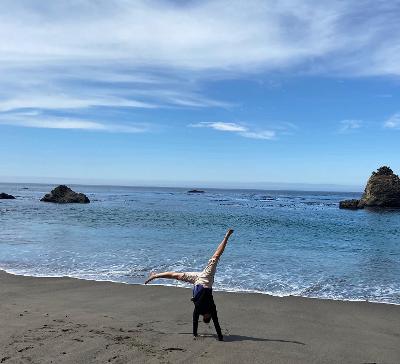I can’t exactly pinpoint when my journey along a
spiritual path began, but I can recall that I had moments of awe and
inspiration from a young age when in nature. I was lucky to have a middle-class
family who would go camping on our two-week summer vacations. Both art and
science were needed to pack our canvas Coleman tent, gear, and specifically
designed “camp box” into the back of our Ford station wagon for six people. Dad
custom-built the camp box, which housed everything needed for cooking, and angled it into the tailgate of the car in order to maximize space. Once the camp list had
been agreed upon and all loaded, we would head off to one of the many State and
National Parks in California and the western United States. I remember coming
face-to-face with giant sequoias, windy seashores, and the Grand Canyon and
felt the moments of wonder they inspired. I often felt small amidst the giants
and would climb onto anything climbable for a better look, perhaps to gain
perspective. Nature, as it turns out would be my kind of church…holy, sacred,
and connecting me into an inner remembrance of my place in the Universe.
This
week’s theme is about the creation of our own spiritual path, called Sadhana. Sadhana is a Sanskrit term used to refer
to a daily spiritual practice from the root sadhu, meaning “go straight
to a goal”. Routinely applying mind, body, and spirit in the pursuit of a
spiritual intention is the most natural and efficient way to surrender the ego,
to find relief from suffering, and to attain peace. As practitioners of yoga, the
thing that drives our practice is the combination of Seva (selfless service), sadhana
(our individual spiritual path), and Satsang
(community). And although we talk about sadhana within the context of the other
two, it is completely an individual journey.
If
you’ve been to India, you most likely saw “sadhus”, or holy men who have
renounced the world in pursuit of spiritual liberation. They have few, if any,
possessions, often have particular austerities, and live off of alms. One sadhu
has held his arm above his head (yes, non-stop) for the past 43 years as a sign
of devotion to Lord Shiva. It’s a practice of devotion and transcending the
physical body. I, however, prefer a different path, not renouncing the world
but living as a householder which means I have other things in my life besides
devotion: possessions, an occupation, and a significant other. So the practice
for the one-armed sadhu is not the path for ordinary me…yet, we both have our
own journey underway.
Sadhana
doesn’t have a particular dogma connected to it and it may change as you go
through your life. I grew up in a Christian household and realized fairly early
on that it didn’t resonate with me. Over time, I found things that did,
particularly studying philosophy as part of my undergraduate degree and various
daily practices began to send roots into my inner soil with deepening
self-study and exploration into yogic philosophy, in particular, the
eight-limbs of yoga. The eight-faceted path gave structure to practices that I
could do and configure to the dynamics of my life, building on what felt right
deep within.
Later
in my life, it feels like I know the path along which I tread. I don’t know
where it’s going, or what may unfold in the process, but I have identified
myself as a spiritual being yearning to tap into my true self. When we know
what calls us forth, we are able to create the steps needed to keep us aligned
with our intention. What I do know, is that I want my path to be one that
includes compassion and ease, as well as growth and trusting the unknown. I
know that my daily rituals have a certain pliability to them, morphing as I
change not only physically but mentally as well. I recognize that what worked
in the past served and taught me well yet may not be what’s right for me today
As
I project into the future, I know what continues to propel me along my personal
path is how I can be of service, not only to my own needs but the needs of
others. Additionally, it’s important for me to have the backbone of a community
in which guidance and accountability are present. I trust that what you need to
know will show itself to you. I trust that if you have a sense of your own
“north star” no matter what steps you take, they will be the right ones
for your own journey. Travel well, my fellow seekers!


















